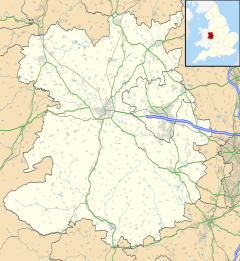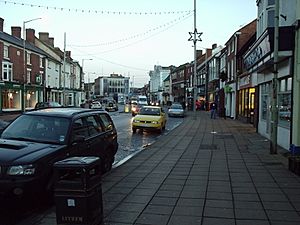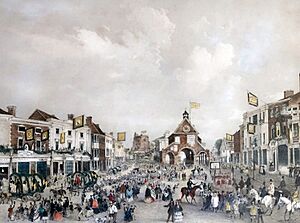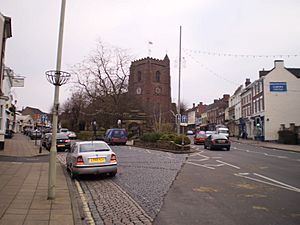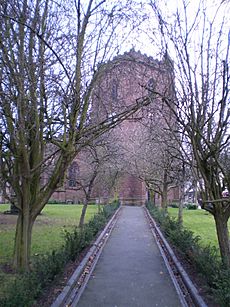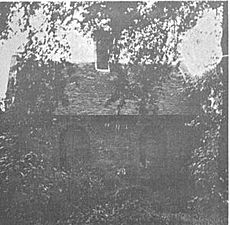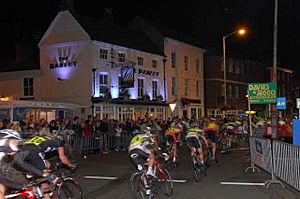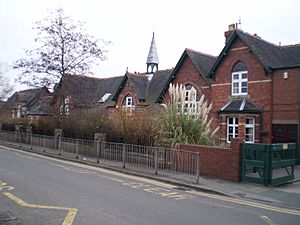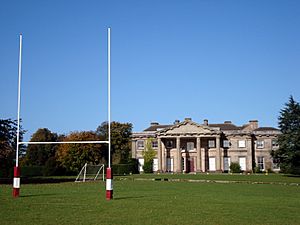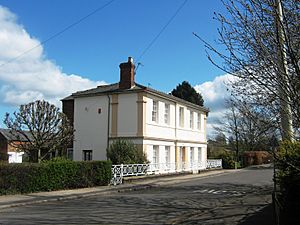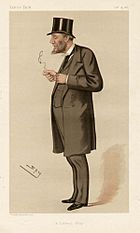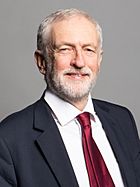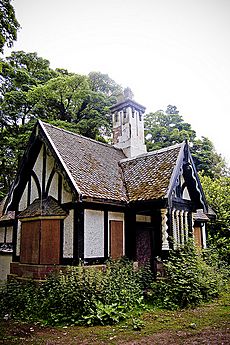Newport, Shropshire facts for kids
Quick facts for kids Newport |
|
|---|---|
| Town and civil parish | |
|
From the top clockwise: Newport from Cheeny Hill, Newport Guildhall, High Street, Pulestone Cross and St Nicholas Church |
|
| Population | 14,182 (2021 Census) |
| Demonym | Novaportan |
| OS grid reference | SJ745191 |
| • London | 148 miles (238 km) SE |
| Civil parish |
|
| Unitary authority | |
| Ceremonial county | |
| Region | |
| Country | England |
| Sovereign state | United Kingdom |
| Post town | NEWPORT |
| Postcode district | TF10 |
| Dialling code | 01952 |
| Police | West Mercia |
| Fire | Shropshire |
| Ambulance | West Midlands |
| EU Parliament | West Midlands |
| UK Parliament |
|
| Website | Official website: https://www.newportshropshire-tc.gov.uk/ |
Newport is a busy market town in Shropshire, England. It is part of the Telford and Wrekin area. The town is about 7 miles (11 km) northeast of Telford and 12 miles (19 km) west of Stafford. It is also very close to the border with Staffordshire. In 2021, about 14,182 people lived in Newport.
Contents
What's in a Name?
The Normans planned a new town called Novus Burgus, which means "New Town". This was built near an older Anglo-Saxon village called Plesc. Over time, the name changed from Novus Burgus to Nova Porta, then to Newborough, and finally to Newport around 1220.
Where is Newport Located?
Newport was chosen as a town site for a few reasons. It was close to an old Roman Road called the Via Devana. This road ran from Colchester to Chester. The area also had many fisheries, which were important for food. The River Meese flows north of the town.
Newport sits on a sandstone ridge. This ridge is on the eastern edge of the Welsh Marches. To the west is Aqualate Mere, the biggest natural lake in the English Midlands. After the last ice age, this area was covered by a huge lake called Lake Lapworth. This lake formed from melting glaciers. People have found ancient log boats about 1 mile (1.6 km) from Newport. One of these boats is kept at Harper Adams University nearby.
Villages like Church Aston, Chetwynd, and Longford are next to Newport. However, they are still separate villages. The village of Edgmond is just west of Newport.
Newport used to be important for industry. It helped the mining areas to the east of Shropshire. But like many market towns, it was also affected by mass-produced goods. These new goods replaced traditional crafts.
Newport can have very cold winters. On January 11, 1982, the lowest temperature ever recorded in England was in Newport. It was a freezing -26.1°C (-15°F)! This was so cold that even diesel fuel froze.
Newport's Past
Newport was part of the ancient kingdom of Mercia. People lived in this area long before Newport became a town. Once it was built, Newport became a market town. It was a central place for farming between Stafford and Shrewsbury.
Saxon Times
In Saxon times, there were two settlements nearby. One was called Eastun, which is now Church Aston. The other was Plaesc, which is now Newport. In 963 AD, Plaesc had a High Street, a stone quarry, and a religious community. The name Plaesc means "shallow pool". Today, not many signs of the Saxon settlement remain.
Norman to Tudor Times
After the Norman Conquest, the land where Newport is now was part of Edgmond manor. William I gave this land to Roger, Earl of Shrewsbury. Later, Henry I founded the new town, first called Newborough.
Newport was not mentioned in the Domesday Book of 1086. This was not unusual, as other important towns were also left out.
The Normans planned the new town during Henry I's rule. The wide main street was made for the market. The narrow plots of land running off it are typical of Norman architecture. Today, only Newport Guildhall and Smallwood Lodge clearly show Tudor buildings. This is because a big fire in 1665 destroyed most of the High Street.
Medieval Newport was successful with trade in leather, wool, and fish. People from Newport even had the right to provide fish for the Royal family! Many half-timbered buildings from the late medieval and Tudor periods show how well the town was doing. Henry I granted the first market charter.
There might have been a castle in Newport, but no visible remains exist today. The most likely spot was where a manor house once stood at Upper Bar.
One reason for Newport's early wealth was the surrounding fisheries. The town's people had to take fish to the Royal court. Later, Henry III said they only had to take fish within Shropshire.
The people of Newport received special rights from Henry I. These rights were confirmed by later kings. In 1551, Edward VI officially made Newport a town with its own governing body. This body was later changed and then replaced by a local council in 1894.
Stuart to Regency Times
In 1665, the Great Fire of Newport damaged many buildings. Only a few medieval structures survived. However, many beautiful Regency and Georgian buildings were built after the fire. These new buildings made Newport's main streets wider and more open than other towns of its age.
Local Estates
By the 1800s, large estates surrounded Newport. These estates, like the Lilleshall estate of the Duke of Sutherland, greatly influenced the town's size and growth. Other important estates included Woodcote Hall, Longford Estate, Chetwynd Park estate, and Aqualate Hall. These powerful families were highly respected in the town until at least the First World War.
20th Century
Newport was lucky during World War II. On Christmas Eve 1944, a V-1 flying bomb aimed at Manchester landed in a field near Newport. It caused no civilian deaths. This bomb is now on display at Royal Air Force Museum Cosford.
The railway line through Newport closed in 1964 for passengers and completely in 1967. The tracks were removed, and houses were built on the land.
In the 1960s and early 1970s, many people in Newport worked in local industries. But most of these jobs disappeared in the late 1970s and early 1980s.
On November 23, 1981, a small tornado passed over Newport. It caused some damage in the town.
On January 11, 1982, the lowest temperature in England was recorded at Harper Adams University College near Newport: -26.1°C (-15°F).
Modern-Day Newport
Today, Newport is mostly a commuter town. Many people live here and travel to nearby cities like Telford, Shrewsbury, Stafford, and Wolverhampton for work.
For a long time, not much new building happened in Newport. But starting in 2007, Telford and Wrekin Council began to invest in the town. There were big plans to improve the canal area, the High Street, and add new homes, shops, and restaurants. New sports facilities, like a climbing wall, were also built.
In 2010, a £1.5 million plan to improve the town began. This included redeveloping Victoria Park. Later, the High Street pavements were redone, and the area around the Puleston Cross was changed.
In 2011, plans were announced for new homes, a supermarket, and a business park near the A518 road bypass. House prices in Newport are among the highest in the county.
The town is also working to become a Transition Towns and Fairtrade Town.
Places to See and Things to Do
The High Street
Newport's main street follows its original Norman design. It is long and wide, split into three parts: Upper Bar, Lower Bar, and St Mary's Street. In the middle of the High Street is the 19th-century Town Hall and Market Hall, finished in 1860.
The St Nicholas Church and the Puleston Cross are on an island in the middle of the High Street. St Mary's Street splits off and rejoins the High Street around this island. After the 1665 fire, grander Georgian architecture buildings replaced the old Norman ones. These buildings still stand today.
Newport still has many shops on High Street, Stafford Street, and St Mary's Street. St Mary's Street has cobblestones and mostly small boutiques. It also hosts various markets and fairs.
You can find well-known businesses like Costa Coffee, Boots, and Subway in Newport. There are also industrial estates like Mere Park near the A518 road bypass.
Other Interesting Places
The oldest man-made landmark is the Puleston Cross. This is a 13th-century cross near St Nicholas Church. It marks where the market used to be. The cross remembers Sir Roger de Pyvelesdon, who died in 1272.
At the top end of town is the Combat Stress centre. It was built in 1908 as a hospital for the Newport Workhouse. Today, it helps veterans with mental health issues.
The town is also close to Aqualate Mere, the largest natural lake in the English Midlands.
-
St Nicholas's Church & Newport war memorial
Religious Buildings
The first religious community in Newport was recorded in 963 AD. It was the church of St Mary Magdalene.
Newport is in the Church of England Diocese of Lichfield and the Roman Catholic Diocese of Shrewsbury. St Nicholas Church dominates the town centre. It was built during the reign of Henry I.

The St Peter and Paul Catholic church was built in 1857. It is the oldest Catholic church in Shropshire and was designed by Augustus Pugin.
The ruins of Lilleshall Abbey are about 4 miles (6.4 km) from town. This abbey was founded in 1145. A smaller Baptist church was built in the 1960s.
Newport has had many religious sites over time. Some old churches have been used for other purposes or even demolished. For example, the Newport Independent Chapel (built 1831) merged with the Methodist Chapel in 2001 to become Trinity Church.
Newport General Cemetery opened in 1859. It has a chapel and war graves from World War I and II.
Economy
Newport is a central place for the farming community in the Shropshire/Staffordshire border area. It is also a local business hub. The Football Association's Medical and Exercise Science Department is based at Lilleshall Hall nearby.
Education is a big part of Newport's economy. The town has two selective state schools and a large comprehensive school. Harper Adams University is just outside town, and Keele University uses rooms in the local doctor's office for student doctors.
Shopping is also important to the town's economy. Most shops are on the High Street. Larger stores are found on the Audley Avenue and Springfield trading estates.
Culture and Events

Cosy Hall is a venue used for the Newport music festival. The Newport Guildhall is a medieval timber-framed building from around 1400.
Town Events
Newport hosts many events throughout the year. Six main events bring many people to the town. The Newport Show is held yearly at Chetwynd Deer Park. It started in 1890 and now attracts 13,000 visitors each year.
Other big events in town include the Newport Carnival and the Newport Old Tyme Market. The biggest event is the Newport Nocturne Bike Race, which happens every two years.
Heart of England in Bloom
Newport has won many awards in the Heart of England in Bloom competition. In 2009, it was the first town to win six gold awards in a row! In 2010, it won its seventh gold medal.
Media
Newport has a local community radio station called NOVA FM, broadcasting on 97.5FM. You can also listen to regional stations like Greatest Hits Radio Midlands and BBC Radio Shropshire.
Local news and TV shows are provided by BBC West Midlands and ITV Central.
The Newport and Market Drayton Advertiser is the town's weekly newspaper. It has been published since 1854. The town is also covered by the county-wide Shropshire Star. Nova Magazine is a free monthly magazine distributed in Newport and nearby villages.
Newport in the Media
A book called "Christmas Guisers' Play from Newport, Shropshire" (1883) is about the town. Newport was the first town in Shropshire to be featured on Dickinson's Real Deal. A TV show called The Spy Who Stole My Life (also known as The Spy Who Conned Me) used Newport as a setting. It told the story of Robert Hendy-Freegard, a conman who pretended to be an MI5 agent and tricked students from the town.
Education
Newport has schools for all ages, from primary schools to a university. The selective schools are Newport Girls' High School and Haberdashers' Adams. Harper Adams University is in the nearby village of Edgmond. Keele University also has teaching rooms in the local doctor's office for trainee doctors.
For older students, the closest colleges are Telford College of Arts and Technology and Stafford College. Buses run from Newport to these colleges. Edgmond Hall, just outside town, is used for outdoor activities for school students.
| Infant | Church Aston Infant School · Moorfield Primary School · St Peter & St Paul RC Primary School · Newport Infant School |
| Junior | Newport Junior School · Moorfield Junior School. Castle House School |
| Comprehensive | Burton Borough School |
| Secondary state grammar schools (with sixth form) | Newport Girls' High School & Haberdashers' Adams |
| Universities | Harper Adams University |
Transport
Newport has been an important crossing point for a long time. It sits on the old Via Devana Roman road.
The town became well-known as a coaching town. It was on the Mail coach route between London, North Wales, and Ireland. It was also on a key junction for roads to Chester and the East Midlands. This is why the town grew around these different roads.
In the town centre, there is a large island with St. Nicholas Church at one end. The High Street is on one side of this island, and St Mary's Street is on the other. These two streets meet near the junction with the A518 road, which runs through town from Stafford to Telford. They also meet near the Shrewsbury and Newport Canal. The A519 road from Eccleshall also meets here. At the south end of the High Street, the A519 road continues towards Telford.
Before roads were so important, the canal was the main way to link to the town. It is not currently connected to the national canal network. However, there are plans to restore it fully. This would link it to the national network at Norbury Junction. The A41 road now borders the town to the east. A bypass road opened in 1985 to help with traffic on the High Street.
Newport is about 9 miles (14 km) from the M54 motorway and 11 miles (18 km) from the M6 motorway.
Buses
Buses run between Stafford and Telford, and from Shrewsbury to Newport. Arriva Midlands is the main bus company.
Rail
The old Stafford to Shrewsbury Line used to run through Newport. But Newport (Salop) railway station closed in 1964. The tracks have been removed. There are hopes to reconnect the town to the railway network in the future. This idea is supported by the town council. The line is on a list of "Lines that should reopen" by the Campaign for Better Transport.
Cycling
Newport is on National Route 55 and Regional Route 75 of the Sustrans National Cycle Network. Cycle maps are available from the Newport Visitor Information centre. A cycleway on the old railway line to Stafford is being completed.
Walking
The town is on the Way for the Millennium walkway. This path is 40 miles (64 km) long and goes towards Stafford, passing through several villages.
Sports and Clubs
Newport Town FC plays in the West Midlands (Regional) League. Their reserve team, "Edgmond Rangers", also plays in a local league. Newport Town FC was the league champion in 2011–12. The senior team now plays its home games at Harper Adams University College.
The Newport Crown Green Bowls club plays in the Premier Division of Shropshire.
Newport (Salop) Rugby Union Football Club is the highest-ranked rugby club in Shropshire.
Newport Cricket Club plays in the Shropshire Premier Cricket League.
In 2009, the £200,000 Newport Sk8 park was opened by Princess Anne. It is the largest skatepark in Shropshire.
The 265(Chetwynd) Air Training Corps is based just outside Newport.
Lilleshall Sports Centre
Lilleshall Hall was once a country home for the Duke of Sutherland. It is about 2 miles (3.2 km) from Newport. Today, it is home to Lilleshall National Sports Centre.
Famous People from Newport
Early Times
- Robert Puleston (born in Newport) – A supporter of Owain Glyndŵr.
- Richard Barnfield (1574–1620) – An English poet.
- William Adams (1585–1661) – A London merchant who founded Haberdashers' Adams school.
- Thomas Brown (1662–1704) – A satirist.
1750–1900
- John Meeson Parsons (1798–1870) – An art collector.
- William Ick (1800–1844) – An English botanist and geologist.
- James Brown (1812–1881) – A Roman Catholic Bishop of Shrewsbury.
- Arabella Elizabeth Roupell (1817–1914) – An English flower painter.
- James Hain Friswell (1825–1878) – An English essayist and novelist.
- Charles Cecil Cotes (1846–1898) – A British landowner and politician.
- Colonel William Slaney Kenyon-Slaney (1847–1908) – A sportsman, soldier, and Member of Parliament for Newport.
- Percy John Heawood (1861–1955) – A British mathematician.
- James Edward Quibell (1867–1935) – An Egyptologist.
- Frederick Phillips Raynham (1893–1954) – An early pilot.
From 1900
- Sir Peter James Bottomley (born 1944 in Newport) – A British Conservative Member of Parliament.
- Ozzy Osbourne (born 1948) – A famous heavy metal rock singer. He owned a bar in Newport in the late 1970s.
- Jeremy Corbyn (born 1949) – A Labour Member of Parliament and former leader of the Labour Party. He lived in Newport as a child.
- Peter Butler (born 1951 in Newport) – A British Conservative Member of Parliament.
- M. J. Bassett (born c. 1965 in Newport) – An English screenwriter and film director.
- Michael Beasley (born 1968) – A bishop who served in Newport.
- Robert Hendy-Freegard (born 1971) – A conman who tricked people by pretending to be an MI5 agent.
- Craig Phillips (born 1971) – The winner of Big Brother 2000.
- James Sutton (born 1983) – An English actor.
Sportspeople
- Thomas Collins (1841–1934) – A first-class cricketer and headmaster of Newport Grammar School.
- Herbert Denis Edleston Elliott (1887–1973) – An English cricketer.
- Reuben (Ben) Jones (1932–1990) – An Olympic equestrian.
- Paul Bracewell (born 1962) – A footballer who played for England.
- Adam Proudlock (born 1981) – A youth team coach for Newport Town and former professional footballer.
- David Pallett (born 1990 in Newport) – An English darts player.
- Callum Burton (born 1996 in Newport) – An English football goalkeeper.
- Ben Rowlings (born 1996) – A British Paralympic athlete.
Nearby Villages and Hamlets
Newport is surrounded by many smaller villages and hamlets. Most of these are very close to the town. They are often considered part of Newport's local area. Some of these villages are actually in Staffordshire, but they still use Newport in their postal address.
Here are some villages and settlements near Newport:
- Church Aston
- Chetwynd
- Longford
- Edgmond
- Moreton, Staffordshire
- Meretown
- Adeney
- Stockton, Shropshire
- Pave Lane
- Bromstead Heath (Staffordshire)
- Great Chatwell (Staffordshire)
- Gnosall (Staffordshire)
- Forton, (Staffordshire)
- Coley (Staffordshire)
- Outwoods (Staffordshire)
- Wilbrighton (Staffordshire)
- Tibberton
Closest Cities, Towns, and Villages
 |
Hodnet, Whitchurch | Hinstock, Market Drayton | Woodseaves, Eccleshall, Newcastle-under-Lyme, Stoke-upon-Trent |  |
| Edgmond, Tibberton, High Ercall, Shrewsbury | Gnosall, Stafford | |||
| Lilleshall, Telford | Shifnal, Bridgnorth | Albrighton, Wolverhampton, Birmingham |
Images for kids
See also
 In Spanish: Newport (Shropshire) para niños
In Spanish: Newport (Shropshire) para niños







